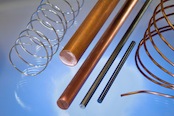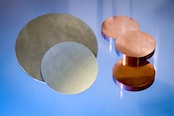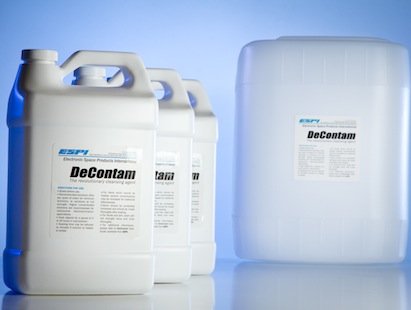Indium Foil and Sheet
 |
 |
| INDIUM FOIL | INDIUM SHEET |
INDIUM - HISTORY AND USES
Ferdinand Reich and Hieronymus Theodor Richter discovered Indium in 1863, while analyzing a zinc ore sample through spectro-analysis. where They witnessed a blue spectral line as opposed to the anticipated green thallium line they were expecting. This led to the realization that they had discovered a new element naming it Indium (In) after the Indigo blue spectral line present.
Indium is classified as the 61st most abundant element in the environment, is reletively low in toxicity and is soft and malleable with a melting temperature of 157 oC. Indium is used in many cryogenic applications because it remains pliable down to temperatures approaching absolute zero. While indium melts at a low temperature it has a very high boiling point of 2080 oC. It's malleable characteristic coupled with its ability to cold solder itself to a variety of materials makes indium foil and sheet an excellent choice for gaskets and seals. Indium is soft and easily deforms onto the surface of mating parts making it an efficient thermal conductor for use in the electronics industry. Indium's low vapor pressure makes it a good choice for high vacuum applications.
Indium did not find wide spread use until the Second World War in which it was used as an additive to steel to improve strength. The semiconductor industry finds indium useful in the synthesis of semiconductor materials for the manufacture of thin film solar cells. A principal use is in the forming of electrodes for touchscreens and liquid crystal displays. A transparent conductive coating of Indium oxide and Indium tin oxide is applied as a substrates to glass in the manufacture of electroluminescent panels. Indium is especially suited to being used in vacuum systems due to its sealing properties and as a bonding material in acoustic transducers.
INDIUM FOIL AND INDIUM SHEET
Indium foil and indium sheet are regularly used as an extremely efficient heat sink for high temperature and cryogenic applications. The semiconductor industry finds indium useful in the synthesis of semiconductor materials for the manufacture of thin film solar cells. A principal use is in the forming of electrodes for touchscreens and liquid crystal displays. A transparent conductive coating of Indium oxide and Indium tin oxide is applied as a substrates to glass in the manufacture of electroluminescent panels. Indium is especially suited to being used in vacuum systems due to its sealing properties and as bonding material in acoustic transducers.
ESPI provides high purity foil and sheet in many different elements for distribution to universities, research labs and manufacturing companies in numerous purities and form factors (i.e., wire, rod, ribbon, shot, pellets, pieces, powder, sputtering targets, discs and custom fabricated parts). We are able to fabricate all the above to your specification. For form overviews on wire and rod manufacturing or additional detailed information on ESPI's other production offerings, click here.
IN-STOCK, READY TO SHIP INDIUM
ESPI stocks several pre-fabricated items shown in the table below that are available for same day shipment.* To view the Ready to Ship products, click here. For a quotation, call, e-mail or click "Chat Now" for immediate assistance.
To view various forms and purities of Indium, click on the Indium On-Line Catalog page.
|
|
* Approved customers and orders needs to be place by 1:00 PM Pacific.
For more technical and historical information see: en.wikipedia.org/wiki/Indium For a Material Safety Data Sheet (MSDS) see: www.espimetals.com/index.php/msds/146-Indium
CONTACT AND ORDERING:
541.488.8311 telephone
800.638.2581 toll-free
541.488.8313 fax
800.488.0060 toll-free fax
This email address is being protected from spambots. You need JavaScript enabled to view it.
GENERAL PROPERTIES
|
Symbol: |
In |
|
Atomic Number: |
49 |
|
Atomic Weight: |
114.82 |
|
Density: |
7.31 gm/cc |
|
Melting Point: |
156.61 oC |
|
Boiling Point: |
2080 oC |
|
Thermal Conductivity: |
0.818 W/cm/K @ 298.2 K |
|
Electrical Resistivity: |
8.37 microhm-cm @ 20 oC |
|
Electronegativity: |
1.7 Paulings |
|
Specific Heat: |
0.056 Cal/g/K @ 25 oC |
|
Heat of Vaporization: |
53.7 K-Cal/gm atom at 2080 oC |
|
Heat of Fusion: |
0.781 Cal/gm mole
|
|
|

 ALLOYS
ALLOYS 





